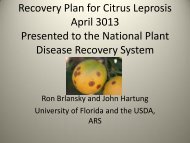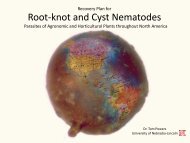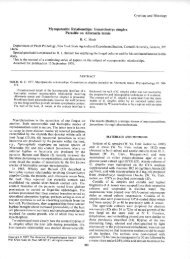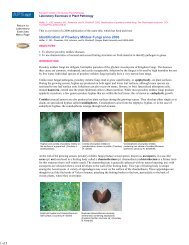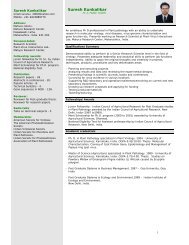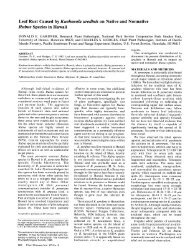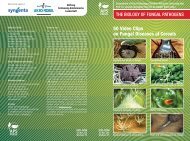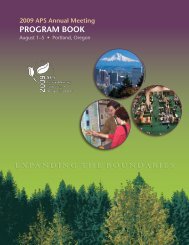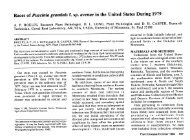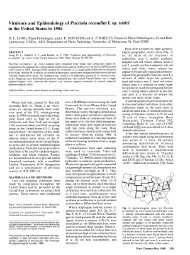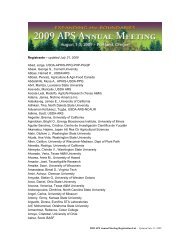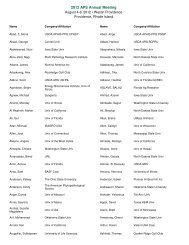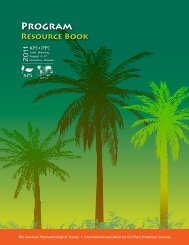view article - American Phytopathological Society
view article - American Phytopathological Society
view article - American Phytopathological Society
Create successful ePaper yourself
Turn your PDF publications into a flip-book with our unique Google optimized e-Paper software.
308 312<br />
SYSTEMIC RESISTANCE TO TOBACCO MOSAIC VIRUS INDUCED IN SUSCEP- INHIBITION OF TOMATO BUSHY STUNT VIRUS BY DEFECTIVE INTERFERING<br />
TIBLE PLANTS AFTER LOCALIZED INFECTIONS BY TOBACCO NECROSIS PARTICLES IN TOBACCO PROTOPLASTS. R. W. Jones, A. 0. Jackson and<br />
VIRUS. D. A. Roberts, Univ. of Florida, Gainesville, FL 32611. T. J. Morris, Dept. of Plant Pathology, Univ. of California,<br />
Berkeley, CA 94720.<br />
The lowest three expanded leaves of plants of Turkish tobacco<br />
(Nicotiana tabacum L. 'Samsun'), susceptible to tobacco mosaic Defective interfering (DI) p<strong>article</strong>s of tomato bushy stunt virus<br />
virus (TMV) but hypersensitive to tobacco necrosis virus (TNV), (TBSV) are small RNAs generated from genomic RNA, which attenuate<br />
were inoculated with TNV. Leaves of comparable control plants disease symptoms. The effect of DI presence on TBSV replication<br />
were mock inoculated with juice from healthy plants. One week was determined by PEG-mediated protoplast inoculation of TBSV<br />
later, two expanded leaves above the TNV-inoculated and mock- genomic RNA, with or without DI RNA. Protoplasts were derived<br />
inoculated ones were challenge inoculated with TMV. TMV-inocu- from Nicotiana edwardsonii, N. benthamiana and N. tabacum. In<br />
lated leaves and those systemically infected were harvested and each tobacco, DI replication, based upon tritiated uridine<br />
frozen, respectively, one and two weeks after the challenge in- incorporation, was directly correlated with the quantity of DI<br />
oculation. Infectivity of TMV in the juice from thawed leaves inoculum added. Inoculation of equal amounts (1:5 molar ratio)<br />
was assayed by the half-leaf method in Samsun NN Turkish tobac- of genomic and DI RNA markedly inhibited TBSV genomic RNA<br />
co. In six experiments, infectivity of TMV in TMV-inoculated accumulation within 18 hr. In contrast, DI RNA continued to<br />
leaves was significantly (P = 0.01) reduced below that in the accumulate between 18 and 39 hr and reached a 20-fold greater<br />
controls by an average of 19%, in the systemically infected molar ratio over that of genomic RNA. Data indicates that the<br />
leaves, by 32%. Thus, replication of TMV was slowed in plants disease attenuation found in the presence of DI RNA may be<br />
of Turkish tobacco previously inoculated with TNV. directly related to a suppression of genomic RNA synthesis.<br />
309 313<br />
PURIFICATION OF THE RMV AND SGV ISOLATES OF BARLEY<br />
YELLOW DWARF VIRUS FOR ANTISERUM PRODUCTION. G.N. ANTISERA TO CYTOPLASMIC INCLUSION PROTEINS OF POTYVIRUSES<br />
Webby and R. M. Lister, Purdue Univ., W. Lafayette, IN 47907, and S. M. CONTAIN CROSS-REACTIVE ANTIBODIES. John Hammond. USDA-ARS,<br />
Gray, Cornell Univ., Ithaca, NY 14853. Florist and Nursery Crops Laboratory, Beltsville, Md. 20705.<br />
Past attempts to purify the RMV and SGV isolates of barley yellow dwarf Antisera against the cytoplasmic inclusion proteins (CIPs) of<br />
virus (typifying those transmitted specifically by Rhopalosiphum maidis and sweet potato feathery mottle (SPFMV), iris severe mosaic (ISMV),<br />
Schizaphis graminis, respectively) have resulted in very poor yields (e.g. less bean yellow mosaic (BYMV), clover yellow vein (CYVV), and turnip<br />
than 50 .lg.Kg-1 plant tissue for SGV). Moreover, production of useful mosaic (TuMV) viruses were used to probe Western blots and dotvirus-specific<br />
antisera has proved difficult due to contaminating plant blots of potyvirus CIPs. On Western blots antisera to SPFMV,<br />
antigens. We have investigated enhancing yields and purity of these isolates BYMV, CYVV and TuMV CIPs each reacted with 17 potyvi rus CIPs;<br />
for the production of specific antisera of high titer. Propagation factors ISMV-CIP antiserum reacted with fewer. Cross-reactivity was<br />
examined included host, environmental conditions, harvest time, and plant much reduced on dot-blots; specific reactions above background<br />
parts used. For purification, a procedure previously developed at Purdue for were not observed with all sera. The cross-reactivity is<br />
other isolates was evaluated and modified for use with RMV and SGV. presumably due to antibodies reactive with conserved sequences<br />
Improved yields (2-400 ýtg.Kg-l) of each were obtained using oat shoots, not exposed on the native subunit but accessible on denatured<br />
ground in liquid nitrogen, and extracted by repeated blending in 0.5 M proteins; this would explain the superior activity on Western<br />
phosphate, pH 6.0. Incorporating macerating enzymes during extraction blots compared to dot-blots, and the greater virus-specificity<br />
reduced yields slightly. When injected into rabbits the preparations yielded previously observed by others in gel-diffusion tests with<br />
polyclonal antisera readily capable of discriminating RMV and SGV from antisera against potyvirus CIPs. Thus potyvirus CIPs and coat<br />
other isolates by DAS-ELISA. proteins may both have virus-specific exterior epitopes, and<br />
conserved interior sequences.<br />
310<br />
EPITOPE DIVERTITY AMONG CITRUS TRISTEZj VIRUS ISOLATES. 314<br />
S. M GarH. C e T. Kano T A. Permar . M. Cambra 2 COMPARISON OF ELISA AND DOT BLOT HYBRIDIZATION FOR DETECTING<br />
M. Koizumi , and C. Vela . USDA, ARS 3Orlando, FL, Fruit Tree TOMATO RINGSPOT VIRUS IN NECTARINE TISSUE. C.A. Powell, A.<br />
Research Station, MAFF, Okitsu, Japan, Instit~to Valenciano<br />
Investigaciones Agrarias, Moncada, Spain, and Ingenasa, 41<br />
Hermanos Garcia Nobelas, Madrid, Spain.<br />
tladidi, and J.M. Halbrendt. AREC, Univ. of Florida, Fort Pierce,<br />
FL 34954; USDA. ARS, Beltsville, MD 207G5; and Fruit Research<br />
Lab, Penn State Univ., Biglerville, PA 17307.<br />
4 ~1<br />
At least five distinct epitopes were detected in citrus tristeza Approximately I g of leaf, bark, or root tissue from 20-yearvirus<br />
(CTV) when 28 selected CTV isolates from Japan, Florida, old nectarine trees with symptoms of the Prunus stem pitting<br />
and Brazil were tested against a polyclonal antiserum (PCAS) (PSP) disease was frozen in liquid nitrogen, triturated with a<br />
and four monoclonal antibodies (MCA). IgG from the PCAS was mortar and pestle, and thawed in PBS. One-half of each sample<br />
used as trapping antibody, and the Spanish MCAs, 3DFI and 3CA5, was analyzed for TmRSV antigen by DAS ELISA. Total nucleic<br />
and the Florida MCAs, MCA13 and MCA14, were used as intermediate acid was extracted from the remainder of each sample using<br />
antibodies in double-sandwich indirect ELISA. Binding specificity<br />
of each MCA among the isolates was distinct. None of the<br />
phenol/chloroform and analyzed for TmRSV-specific RNA by dot<br />
blot hybridization with a 3 2 p-labeled cRNA probe. DAS ELISA dofour<br />
MCAs reacted with all isolates tested, but all isolates<br />
reacted to the PCAS in double-antibody sandwich direct ELISA.<br />
tected TmRSV in 0 of 17 leaf samples, 8 of 17 bark samples, and<br />
12 of 17 root samples. Uot blot hybridization detected TmRSV<br />
Many field sources of CTV apparently contain complexes of CTV RaNA in U of 17 leaf samples, 17 of 17 bark samples, and 3 of 17<br />
serotypes. root samples. Total nucleic acid was extracted from bark collected<br />
from various locations on two young nectarine trees with<br />
'SF. TmRSV RNA was detected by dot blot hybridization from bark<br />
where PSP) symptoms were visible.<br />
311<br />
CROSS PROTECTION AND RELATIONSHIPS AMONG BARLEY 315<br />
YELLOW DWARF VIRUSES. F. Wen and R. M. Lister. Department of THEORY<br />
Botany and Plant Pathology, Purdue Univ., W. Lafayette, IN 47907.ELS.PN.Brosad0W.<br />
OF TESTING FOR SEROLOGICAL IDENTITY IN QUANTITATIVE<br />
anet ClmnUivsty<br />
Studies on cross protection in barley yellow dwarf viruses (BYDV) using Clemson, South Carolina 29634.<br />
ELISA and cDNA probes (Phytopathology 78: 1587) were extended to<br />
include additional isolates representing different serological groups and Curwes of optical density response to dilutions of antigen<br />
serotypes. The serotypes were: PAV (non-specifically transmitted by preparations are characterized by parametric functions which<br />
Sitobion avenae and Rhopalosiphum apidl~dd); MAV (specifically transmitted by provide a definition of serological identity for virus isolates<br />
S. avenae), and SGV (specifically transmitted by Schizaphis graminum),<br />
regarded as Group 1 serotypes, and RPV (specifically transmitted by R. padJi)<br />
in terms of hypothesized parametric identities that can be<br />
tested for each antiserum. The necessity of allowing for<br />
and RMV (specifically transmitted by R_. maidis), regarded as Group 2 unknown and different antigen concentrations, in virus<br />
serotypes, together with two closely related serotypes derived by preparations before dilution, reduces the number of vulnerable<br />
subculturing from an MAV source. Cross protection was most efficient and parametric identities by one. Combined analysis of response<br />
persistent between the two serotypes derived from MAV, and undetectable curwes from different antisera changes the definition of<br />
between RPV and either MAV or PAV. Other combinations also showed that serological identity and increases the sensitivity of the test.<br />
the degrees of cross protection obtained were consistent with serological This method can be validated by 'blind' testing of different<br />
relationships as indicated by ELISA, and with genomic relationships as preparations of the same virus isolate for which the hypothesis<br />
indicated by eDNA hybridizations and sequencing information, of serological identity should not be rejected.<br />
1174 PHYTOPATHOLOGY



